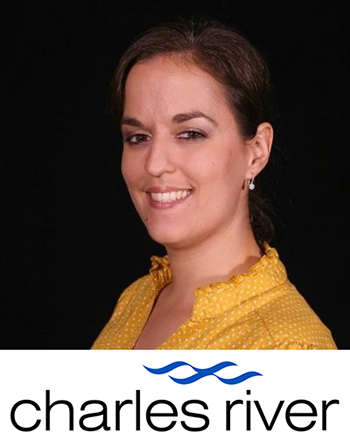
Interview with Dr. Anne Wagner, Technology & Market Development Manager for Consumer Products on the Microbial Solutions team at Charles River Labs
Dr. Anne Wagner, Technology & Market Development Manager
Charles River Labs
What are the advantages of a rapid microbial detection method?
A rapid detection method replaces subjective traditional testing with an automated analysis, giving you a “Yes/No” answer, providing critical information whether to release or hold products. Companies can reduce traditional microbial limits testing from 3-7 days down to 24 hours, streamlining production and rapidly confirming product quality with minimal changes to your current test preparation methods. In just 24 hours you’ll have actionable results for bioburden and microbial limits testing, empowering you to make a more confident decision about your products.
Moving to a rapid method can have a significant impact in the lab and operations. When you release products faster, there is a reduction of inventory and working capital requirements - savings particularly appreciated by stakeholders and financial teams. This allows improvement and optimization of warehouses and even in some cases allows you to get rid of rented locations.
What should we look for in a rapid microbial detection method?
The key criteria in selecting a Rapid Microbial Method (RMM) share a common trait: a strong correlation to financial value. The quicker an RMM can help in making appropriate business decisions regarding the company’s products, the greater the financial value that company will realize.
The first consideration in choosing a rapid method is the range of raw materials, work-in-process, and finished goods that can be tested with the system. The full economic benefits cannot be achieved if the method cannot be applied across the majority of a company’s products.
The “rapid” in rapid microbial methods refers to faster time to result, but an additional way to look at “rapid” is this second consideration: throughput and ease of use, or the ability of the rapid method to process samples efficiently with minimal input. Some rapid methods may require multiple extra steps to prepare samples, additional labor to deal with system complexity, or multiple systems to handle throughput requirements.
The last, but not the least, important consideration in selecting an RMM is provider support. Choosing the right rapid method also means having an active relationship with a supplier who has the appropriate validation, scientific and technical support. Without this, it is difficult to obtain maximum efficiencies from the investment. Finding a good team to work with will ensure a smooth implementation and a streamlined product release cycle that enables the company to realize the benefits of the rapid detection technology. Not all rapid methods are created equal.
Can rapid methods work on my entire product portfolio?
A rapid microbial detection platform is only as good as the technology that powers it. Celsis® has the most advanced class of adenosine triphosphate (ATP) bioluminescence reagents, utilizing the ATP bioluminescence assay with luciferase, which is the same enzyme that lights fireflies, to produce light from microbial ATP. Celsis® can be your one stop solution for microbial detection with a single, harmonized platform to test your entire product portfolio – standard products and OTCs. We can test products with high or low viscosity, high or low pH, alcohol or water-based, and a wide variety of preservatives.
Once you encounter a contamination with your RMM, what are my next steps?
The cost of microbial contamination is real with loss of revenue that is acute and long term. Your brand reputation could be negatively impacted and the recovery process from that is long. To prevent that scenario, you need to know what your contamination is as accurately and as fast as possible. There are many ways to identify microorganisms and the method matters. The most unique and accurate identifier of all organisms is its DNA. As you move away from the primary information storage in the DNA, like phenotypic methods, the accuracy and reproducibility decrease.
Accugenix® services include DNA Sequencing and MALDI-TOF analysis. Our MALDI-TOF is fast, reliable, and backed by Accugenix® sequencing at no extra cost. We also offer strain typing and protein-coding gene sequencing when you need to go that extra mile and identify to the subspecies level. With a variety of turnaround times, we can get the accurate ID you need when you need it. It is also necessary for an accurate identification process to be supported by a relevant and validated microbial reference library.
Why – in your opinion – is a comprehensive library database coverage necessary?
Accurate identification helps you make informed decisions on the risk associated with that organism found in your product or environment. If the organism you are trying to ID isn’t in the library – you won't get an ID or worse, you may get an incorrect ID and incorrect assessment of the risk. The accuracy of an identification is dependent on the method used to generate and interpret the data as well as the library database used as a reference. Our Accugenix® diverse organism library is curated in real time by our dedicated staff of PhD scientists, including QC samples from labs around the world. It contains over 14,000 microbial species, including bacteria, filamentous fungi and yeasts relevant to your manufacturing environment.

picture credits: Artfully79, adobe stock
Are there standardized guidelines in risk assessment for consumer care product manufacturers?
Environmental monitoring (EM) is a standard broadly known in the pharmaceutical manufacturing environment. While it’s not mandated for consumer products, many companies are implementing environmental monitoring to enhance safety standards. EM programs are early warning systems that will save you time and money with faster and more effective investigations. A contamination response can involve manufacturers having to collect and then destroy finished goods, clean manufacturing sites, and require a strategy to ensure that it never happens again.
Manufacturing is complex and fast paced, and contamination events have a significant impact. Let’s use a train system as an analogy for a consumer care manufacturing site. Your production line is like a train line and has many direct and indirect connections including operations, HVAC, or water quality systems to name a few. If you have found a contamination in your product its origin could have come from anywhere. If the contamination did not come from your manufacturing equipment, no amount of cleaning will solve the problem.
The first step in contamination response should be figuring out what it is. You have confirmed the microbe’s identification, but how did it get there? Was it a contaminated raw material? Contaminated dust flowing through your HVAC system? An issue with poor quality in your water filtration? Without a baseline of your environment, every contamination event puts you at square one to identify the cause. That microbe could have come from anywhere. With EM, you change your manufacturing processes from reactive to proactive.
What can Charles River Laboratories do for consumer care manufacturers?
We’ve purposely built our portfolio to bring you progressive products and services that deliver accurate, relevant, and reliable data to fuel confident decisions on product quality and contamination control. Our unique combination of Celsis® rapid microbial detection in only 24 hours and Accugenix® microbial identification keeps your manufacturing operations running efficiently and smoothly, lowers your cost to manufacture, and protects your reputation.
About Dr. Anne Wagner
Dr. Anne Wagner is the Technology & Market Development Manager for consumer products on the Microbial Solutions team. She has over 15 years of scientific research experience with eight years specifically focused on consumer product research and development. She has a passion for science advocacy and communicating scientific concepts to a variety of audiences along with teaching and mentoring students. She values research that impacts people’s daily lives and is committed to making high quality and ethical scientific contributions. Dr. Wagner earned her bachelor’s degree in chemistry from Mount Holyoke College and her PhD in chemistry from the University of Pennsylvania, which focused on protein engineering to help develop new methods to analyze protein folding. She has authored several academic papers and has been awarded three patents in cosmetic polymer formation.
More Product Information
Celsis® instruments are in use in over 600 locations worldwide by the world’s largest manufacturers. By providing accurate micro results in 24 hours, you can confirm product quality significantly faster than traditional methods, moving products quickly and efficiently into distribution. In the event of a contamination, partnered with Accugenix® microbial identification, can accelerate corrective action and get back on track sooner.
Our Accugenix® customer web portal includes a Tracking and Trending solution for all environmental isolates identified and offers customization features for data entry fields and reports while meeting requirements of 21 CFR Part 11 and GAMP5 standards. Our flexible solutions allow clients to outsource to our experts or use our services in-house.



